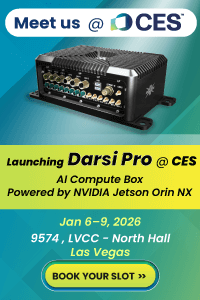Welcome to Vision Vitals, e-con Systems' eye-opening podcast on embedded vision.
Autonomous delivery has moved from pilot projects to daily reality. Packages, groceries, and meals now reach customers through compact robots rolling across streets and sidewalks.
Behind those smooth deliveries lies advanced imaging. Vision systems allow robots to read their surroundings, interpret movement, and make confident decisions on the move.
To explore how camera technology supports that transformation, we're joined by an expert from e-con Systems.
Great to be here. Delivery robots depend on cameras more than any other sensor. Vision helps them travel complex routes, recognize obstacles, and reach drop-off points without supervision.
What roles do cameras actually play once a delivery robot leaves a dispatch station.
Speaker:
From the moment it starts, the robot relies on multiple cameras for awareness. Front modules guide navigation, side cameras watch for pedestrians, and rear units cover reversing or turning.
The cameras feed live data to onboard AI models that estimate distance, detect objects, and classify road elements. That process enables the robot to follow pedestrian zones, stop at crossings, and avoid sudden obstacles like pets or bikes.
Host:
Weather and lighting vary across the day. How does vision remain consistent.
Speaker:
Cameras used in delivery robots must handle strong sunlight, shade, and night lighting. Sensors with High Dynamic Range capture bright and dark details simultaneously, avoiding exposure imbalance.
Low-light sensitivity and Near Infrared capability help the robot operate after sunset or in poorly lit neighborhoods.
e-con Systems integrates tuned ISPs that maintain natural color and contrast under such changing conditions, allowing perception algorithms to stay reliable across every shift.
Host:
Delivery routes often stretch long distances. How do designers manage cabling and signal quality.
Speaker:
Cable length is important because cameras can sit far from the main processor. Interfaces such as GMSL and FPD-Link enable high-speed transmission over several meters with minimal latency.
They resist electromagnetic interference generated by motors or power circuits, keeping video free from distortion. That ensures accurate analysis even when the robot moves through dense electrical zones or near charging stations.
Host:
They resist electromagnetic interference generated by motors or power circuits, keeping video free from distortion. That ensures accurate analysis even when the robot moves through dense electrical zones or near charging stations.
Speaker:
Depth mapping is achieved through stereo vision or Time of Flight sensors. Stereo pairs calculate disparity between two perspectives to estimate distance, while ToF measures how long light takes to return to the sensor.
Those methods give the robot a full 3D layout of its path. It can gauge sidewalk height, detect curbs, and maintain safe clearance around people or parked vehicles.
Host:
Do camera specifications differ depending on robot size or application.
Speaker:
Yes. Compact sidewalk robots favor small-form-factor modules such as MIPI cameras for easy integration with edge SoCs. Larger outdoor units carrying heavy payloads often use GMSL cameras for higher bandwidth and longer reach.
Selecting frame rate, resolution, and shutter type depends on motion speed and required precision in obstacle tracking. e-con Systems validates several camera families for those variations so developers can match sensor capability to real-world needs.
Host:
Autonomous systems must balance accuracy with cost. How does imaging design support scalability.
Speaker:
Scalability comes from modular design. A developer can begin with a two-camera setup for basic navigation and later expand to multi-camera configurations for 360-degree awareness.
Using unified drivers and pre-tuned ISPs across models keeps integration consistent while controlling development time. That flexibility helps manufacturers scale from prototype to volume production without redesigning hardware.
Host:
Security and reliability are key in delivery operations. How do cameras help enforce both.
Speaker:
Vision ensures safety by continuously monitoring the path for pedestrians or unexpected obstacles. At the same time, built-in encryption protocols in GMSL interfaces protect data integrity.
IP-rated housings and vibration-resistant mounts safeguard performance across outdoor temperatures and road conditions. That durability keeps visual data stable for the navigation software and the control network.
Host:
Can you describe how all those imaging features come together during a real delivery run.
Speaker:
Imagine a robot starting from a hub. The front stereo camera identifies the street layout and generates a local map. Side cameras monitor moving pedestrians. A rear unit checks clearance while turning.
Depth data merges with GPS and wheel odometry to refine localization. When lighting shifts or rain begins, HDR and NIR support maintain visual clarity. That continuous feedback lets the robot complete its trip with accuracy and safety.
Host:
Looking ahead, where do you see camera innovation heading for delivery robots.
Speaker:
Future systems will move toward higher resolution and smaller footprints, paired with smarter on-sensor processing. Cameras will handle more analytics before data even reaches the CPU.
As 5G connectivity expands, robots will also share visual data with cloud networks for fleet optimization and remote diagnostics. The combination of compact sensors and intelligent imaging pipelines will push last-mile automation to wider adoption.
Host:
That's an exciting direction.
To explore e-con Systems' range of cameras supporting delivery-robot platforms — from stereo and ToF modules to GMSL-based multi-camera kits — visit www.e-consystems.com.
We appreciate you listening to Vision Vitals. Stay observant and join us next time as we continue uncovering how embedded vision is transforming the world around us.
Close Full Transcript



 Mr. Thomas Yoon
Mr. Thomas Yoon +82-10-5380-0313
+82-10-5380-0313










